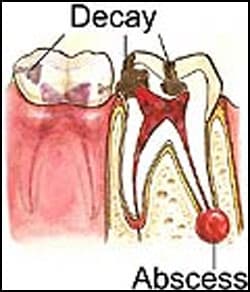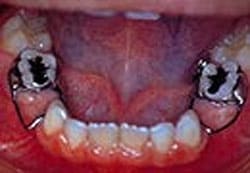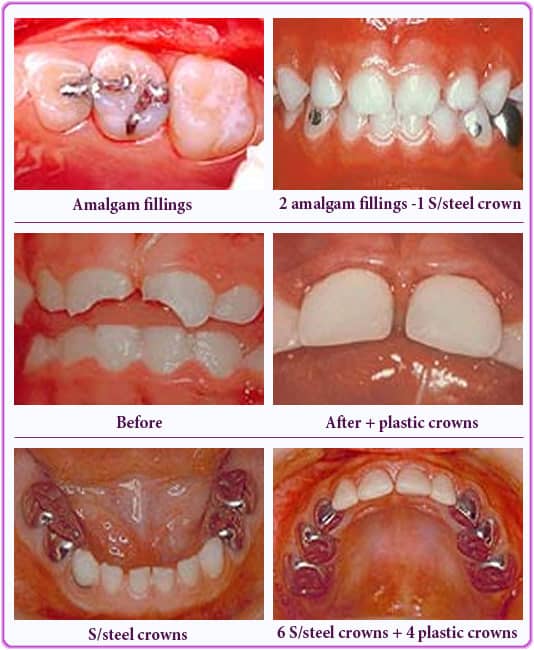Treat cavities for children with teeth filling
If your child develops a cavity in a baby tooth the decay will slowly (and sometimes rapidly) get bigger and deeper. If the tooth is really close to falling out, we have the option of just leaving it alone. If it looks like it may be a while till it would normally fall out, we need to do something. Otherwise, you are in for ugly teeth, toothaches, infection, and more extensive dental work.
1. Why should baby teeth be fixed?
Most babies get their first tooth around 6 or 7 months of age; usually the bottom front two incisors. Some kids are a little slower erupting the first tooth causing parental worry. It can be even around 12 months for the first one to poke through.
Additional baby teeth will continue to come in until almost three years of age. There really is a lot of variability in the sequence. Don’t feel bad if your child does not get his teeth just like your neighbor’s baby or even his own twin sister.
This is important: Look at the chart below and you will see that some baby teeth START falling out around 5-6 years old (again give or take a little), but the back molars do not fall out till around 12 years of age!
If your child develops a cavity in a baby tooth the decay will slowly (and sometimes rapidly) get bigger and deeper. If the tooth is really close to falling out, we have the option of just leaving it alone.
If it looks like it may be a while till it would normally fall out, we need to do something. Otherwise, you are in for ugly teeth, toothaches, infection and more extensive dental work.
A small cavity can be filled with a white filling, a medium cavity can be filled, but a deep or large cavity may need a crown to cover the whole tooth. If the tooth is in the back, the crown may be silver in color. It may even need a nerve treatment. So, get it fixed early when it is small (and less expensive)!
Remember baby teeth are there for a reason. They give the child something to chew with and (importantly) they often save space for the permanent teeth.
Why don’t you just pull it? Well, sometimes that is the best option, but if a back baby tooth is lost too early, without followup treatment, additional crowding problems that are often more difficult to correct will occur.
So you usually will need additional work like a Space Maintainer. That’s one reason why it’s often easier to fix a baby tooth than just remove it.
Here is an ADA eruption chart for general reference:

2. What is a dental restoration?
- It is the repair of a damaged or decayed tooth, restoring it back to its normal shape, appearance, and function.
- A dental restoration is also called a filling.
- The name of the dental material that is used to repair a tooth is often the name given to the repair process. “Amalgam restoration” is an example of the material giving its name to the process.
3. Why should baby teeth be filled or repaired?
- Baby teeth that have decay should be repaired to prevent the decay from spreading.
- Decay can spread, and result in premature loss of teeth.
- Baby teeth should be cared for as they serve the same important purposes as the permanent teeth.
- Baby teeth should be kept in place until they are replaced by permanent teeth. They reserve the space for the permanent teeth to grow into.
- If baby teeth are lost too early, the adjoining teeth can drift into the spaces that are needed for the permanent teeth.
- This can then cause crowding problems because there is insufficient space for the permanent teeth.
4. What are the problems that decay poses for a baby tooth?

- The hard enamel outer covering of a baby tooth is thin.
- A baby tooth also has a large pulp chamber in the center of the crown of the tooth. The pulp chamber houses the nerves and blood vessels.
- When decay penetrates through the enamel, it can spread rapidly through the dentine and on toward the pulp chamber.
- When the dentine is exposed, the tooth will become sensitive to sweet flavors and hot and cold drinks and foods.
5. Is decay in baby teeth easily detectable?
- Decay can be obvious on the chewing surfaces and on the sides of baby teeth.
- It is difficult for the dentist to see decay between the back teeth as they have broad, flat contact surfaces where they meet.
- This feature makes it difficult to detect the onset of decay without the aid of an x-ray.
6. Why is it important to detect decay early?
- Early signs of decay can be dealt with easily before complications set in.
- The smaller the filling, the better the chance the tooth has to stay healthy.
7. Do badly decayed baby teeth need to be extracted?

- An infection or an abscess can result from decay that has spread to the pulp chamber and killed the nerves and blood vessels.
- Extraction of the tooth may then be necessary, as the infection could cause the underlying permanent tooth to develop abnormally. Staining and pitting of a permanent tooth could result.
- Where a tooth has been removed, a “space maintainer” may need to be fitted. This is a device to stop adjacent teeth from drifting into the space that is needed for the permanent tooth to grow into.
8. Does a badly decayed baby tooth need to be extracted?
- Not necessarily. Even when the decay has spread deeply enough into the tooth to expose the pulp chamber, the tooth can still be saved.
- This will require the removal of the nerves and blood vessels in this chamber.
- This procedure is called a pulpotomy or pulpectomy, after which the tooth can be filled. The success of this treatment will depend on the extent of the decay and the degree of infection of the pulp chamber.
9. What is the best way of restoring a decayed baby tooth?

- The tooth can be filled in the normal way if only small amounts of tooth have been lost through decay.
- Amalgam (silver) fillings are found to be the strongest and most durable.
- Amalgam is an alloy or combination of two or more metals.
- Amalgam fillings are made up of mercury, powdered silver, and tin. They are mixed together and packed into cavities in teeth. It hardens slowly and replaces the missing tooth substance.
- Amalgam fillings are held in place by the shape of the prepared cavity. The cavity has to have an undercut to prevent the filling from falling out.
- It is still commonly used, despite an ongoing debate about mercury toxicity.
- White fillings are usually more difficult to place in baby teeth, as the treatment needs a totally moisture-free environment.
- Readymade plastic replacement crowns can be fitted to front teeth that are very badly decayed. This is not a difficult procedure.
- A stainless steel cap or replacement crown is the treatment of choice for badly broken down back teeth. The ready-made cover will prevent further breakdown of the tooth and can be fitted in a single appointment.
Services
Working Time
- Monday - Friday: 08:00 - 19:00
- Saturday: 08:00 - 18:00
- Sunday closed
Contact Info
- Hotline 1: (+84) 908 321 455
- Hotline 2: (+84) 931 857 885
- Mobile: (+84) 8 3925 8778
- Phone: (+84)2 838 258 778
- info@dentalrose.net
- rosedentalclinicvn@gmail.com
 English
English  Tiếng Việt
Tiếng Việt

